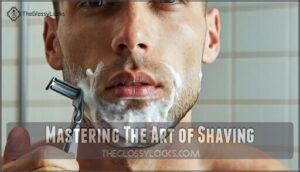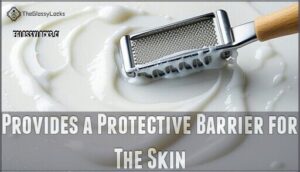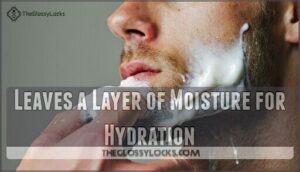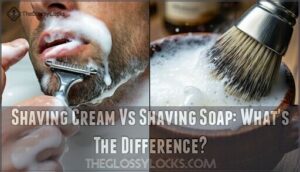This site is supported by our readers. We may earn a commission, at no cost to you, if you purchase through links.
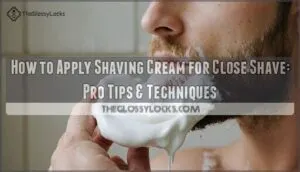
Apply a quarter-sized amount of shaving cream to your fingertips, then massage it onto your face using circular motions against your hair’s natural growth pattern.
This technique lifts whiskers away from the skin, creating the perfect foundation for your razor to glide smoothly, and ensures maximum blade contact.
Work the cream into a rich, protective lather that covers all areas you’ll shave, and don’t rush this step—proper application prevents nicks, cuts, and razor burn.
The secret lies in understanding your hair’s unique growth patterns and choosing the right application method.
Table Of Contents
- Key Takeaways
- Prepare Your Skin for Shaving
- Choosing The Right Shaving Cream
- Mastering The Art of Shaving
- Applying Shaving Cream Like a Pro
- The Benefits of Shaving Cream
- Common Mistakes to Avoid When Shaving
- Shaving Cream Vs Shaving Soap: What’s The Difference?
- Tips for a Smooth Shave and Post-Shave Care
- Frequently Asked Questions (FAQs)
- How do you use a shave cream?
- Should you use shaving cream?
- How do you shave a clogged razor?
- What is a shave cream & how does it work?
- How long should you leave shaving cream on?
- How do you use a shaving cream if you have sensitive skin?
- Does shaving cream help with a close shave?
- What is the 3:1:1 rule for shaving cream?
- What is the best method for a close shave?
- How to properly shave with shaving cream?
- Conclusion
Key Takeaways
- Prepare your skin with warm water first – You’ll need to soak for at least 5 minutes to soften hair and open pores, creating the foundation for a smooth razor glide and preventing irritation.
- Apply cream using circular motions against hair growth – You’ll want to massage a quarter-sized amount in circles opposite to your hair’s natural direction to lift whiskers away from skin for maximum blade contact.
- Create thick, complete coverage before shaving – You shouldn’t see skin through your protective layer, and you’ll need to work the cream into a rich lather that covers all areas you plan to shave.
- Use proper shaving technique with multiple passes – You’ll get the closest results by shaving with the grain first, then reapplying cream for additional passes while maintaining light pressure and short strokes.
Prepare Your Skin for Shaving
Proper skin preparation sets the foundation for a smooth, irritation-free shave that delivers professional results.
Start by soaking your skin with warm water for at least five minutes to soften hair and open pores, making each stroke more effective and comfortable.
Soaking and Softening Hair
Before shaving, proper hair hydration sets the foundation for a smooth experience. Warm water benefits include opening pores and softening stubborn hair, making your razor’s job easier.
Here’s your shaving preparation gameplan:
- Choose your method: Hot shower beats washcloth for full-body coverage, but washcloths work perfectly for facial shaving
- Time it right: Soak for 5-10 minutes minimum – this hydration timeframe allows hair to absorb moisture completely
- Add massage magic: Gentle blood flow massage increases circulation, further preparing skin for shaving cream application
Hot towel usage offers another effective option for targeted skin softening.
Exfoliating and Cleansing The Skin
Cleanliness becomes your secret weapon for achieving razor-sharp results.
Pre-shave exfoliation removes dead skin cells that trap hair and dull blades. Use gentle exfoliating tools like a washcloth or scrub twice weekly, adjusting exfoliation frequency based on your skin type.
Thorough skin cleansing eliminates oils and debris that interfere with cream adherence. This essential skin preparation step enhances pore opening and creates the perfect canvas for smooth shaving, making smooth shaving a more achievable goal.
Pre-Shave Preparations for Sensitive Skin
Anyone with sensitive skin knows that preparation is everything. Start by soaking your face with warm water for five minutes to soften hair and open pores.
Follow with gentle exfoliation using sensitive cleansers to remove dead skin cells without irritation. Sharp blades minimize irritation by reducing the need for multiple passes.
- Apply pre-shave oils to create a protective barrier
- Choose hypoallergenic products specifically for sensitive skin shaving
- Maintain proper hydration importance through your entire preshave routine
Choosing The Right Shaving Cream
Not all shaving creams are created equal, and choosing the right one can make or break your shaving experience.
The right shaving cream transforms a harsh scrape into pure silk against your skin.
The type of cream you select determines how comfortable your shave feels and how close your results will be.
Key Ingredients to Look For
With properly prepped skin, you’ll want shaving cream ingredients that work with your skin, not against it.
Look for these game-changing components:
- Hydrating Ingredients: Glycerin and aloe vera lock in moisture for skin hydration during your shave
- Soothing Agents: Chamomile and natural extracts calm irritation before it starts
- Anti-Inflammatories: Essential oils like tea tree reduce redness and promote healing
These shaving cream ingredients create the foundation for a close shave while keeping your skin smooth and comfortable.
You can purchase shaving cream glycerin online.
Understanding Shaving Cream Vs Gel Vs Foam
Picture three warriors in your bathroom cabinet, each with unique strengths.
Shaving cream creates a thick, protective cushion that’s perfect for sensitive skin and daily shavers. Shaving gel offers transparent precision with superior glide, ideal for detailed work around beards. Shaving foam provides quick convenience but less protection than cream or gel.
Regular use of shaving foam can lead to premature skin aging due to its ingredients.
Type Lather Texture Application
Choose based on your skin type and shaving needs for ideal results.
Benefits of Hypoallergenic and Fragrance-Free Options
Hypoallergenic and fragrance-free shaving cream for sensitive skin offers essential protection against irritation.
These gentle formulas prevent razor burn while maintaining ideal skin health during your daily routine. Many users find relief using specially formulated options.
- Reduced Irritation: Minimizes redness and stinging sensations
- Allergy Prevention: Eliminates harsh chemicals that trigger reactions
- Gentle Formula: Protects delicate skin without compromising shave quality
- Skin Health: Maintains natural moisture barrier throughout shaving process
Mastering The Art of Shaving
Once you’ve got your shaving cream selected and your skin properly prepped, it’s time to focus on your actual shaving technique.
The way you handle your razor and navigate different areas of your face can make the difference between a smooth, comfortable shave and one that leaves you dealing with nicks, irritation, or missed spots.
Shaving Techniques for a Smooth Finish
Master your blade angle by holding the razor at 30 degrees against your skin.
Use skin stretching to create a taut surface, then apply gentle razor pressure with short stroke length movements.
Multiple passes with fresh shaving cream application between each round deliver the ultimate close shave.
These proven shaving techniques transform ordinary routines into smooth shave experiences using quality shaving cream for smooth skin.
Many seek a shaving cream smooth.
Shaving With The Grain Vs Against The Grain
Understanding shaving direction transforms your routine from guesswork into precision.
Hair Direction Mapping reveals your unique growth patterns, while choosing between with-the-grain and against-the-grain techniques affects both comfort and results.
A key decision involves understanding shaving with the grain to minimize irritation.
Grain Combination strategies for ideal results:
- Start with the grain – First pass minimizes Irritation Minimization while removing bulk hair using proper shaving techniques
- Cross-grain second pass – Intermediate step catches missed hairs without aggressive tugging on hair growth patterns
- Against-the-grain finish – Final pass delivers the Closest Shave but requires Multiple Passes with fresh shaving cream
This systematic approach balances comfort with closeness, letting you customize your shave based on skin sensitivity and desired smoothness.
Tips for Shaving Sensitive Areas
When shaving sensitive areas like your neck and bikini line, preparation is key.
Apply shaving cream for sensitive areas with soothing ingredients like aloe vera.
Use light pressure and short strokes to prevent razor burn and ingrown hairs.
Rinse your razor frequently during shaving cream application.
A close shave requires patience—rushing increases skin sensitivity and irritation risk.
Applying Shaving Cream Like a Pro
Proper shaving cream application transforms your shaving experience from a chore into a smooth, comfortable ritual.
The key lies in creating the right lather consistency and distributing it evenly across your skin for maximum protection and glide.
Creating a Luxurious Lather With a Brush
A quality shaving brush transforms your routine into a luxurious ritual.
Soak your brush in warm water for 1-5 minutes to soften bristles and boost water absorption. Work the shaving cream into a rich lather using circular motions, adding water gradually until you achieve a thick, yogurt-like consistency.
The brush type affects lather quality—badger hair retains water better than synthetic options. Apply the cream quantity using light pressure, ensuring proper water temperature for ideal results.
- Brush preparation: Shake off excess water but keep bristles slightly damp for better lather creation
- Lather consistency control: Add water drops gradually to prevent thin or bubbly texture
- Application technique: Use circular motions followed by painting strokes for even coverage
Applying Shaving Cream Directly to The Skin
Without needing a brush, you can apply shaving cream directly using fingertip application techniques.
Start with a nickel-sized amount and work it across damp skin using small circular motions.
This method allows better control over cream quantity while ensuring even coverage.
The lather consistency should feel smooth and protective.
Pay attention to skin sensitivity areas, adjusting pressure accordingly for ideal shaving cream application.
Ensuring Even Distribution for a Close Shave
After applying shaving cream directly to your skin, achieving even distribution becomes your next priority for that perfect close shave.
Proper cream consistency and coverage assessment guarantee the best results every time.
Follow these three shaving cream application steps for flawless distribution:
- Use circular motions with your fingertips or application tools to massage cream into skin, lifting hairs and creating uniform coverage across all areas.
- Check for thin spots by examining your shaving cream consistency – you shouldn’t see skin through the protective layer anywhere on your face or body.
- Apply sectioning technique by working in small areas, addressing reapplication needs immediately when cream starts drying out during your shaving routine.
These shaving cream techniques guarantee complete protection and the smoothest possible shave.
The Benefits of Shaving Cream
Shaving cream acts as your skin’s best friend during the shaving process, creating a protective cushion that prevents nicks and razor burn.
This essential product softens your facial hair while keeping your skin hydrated, making each pass of the razor smoother and more comfortable.
Provides a Protective Barrier for The Skin
Think of shaving cream as your skin’s personal bodyguard.
This protective barrier reduces friction between blade and skin, prevents nicks and cuts during each pass.
Quality shaving cream guards against irritation while enhancing razor glide across your face.
It protects skin from razor burn and creates the cushioning needed for a close shave without damage, acting as a personal bodyguard.
Leaves a Layer of Moisture for Hydration
Beyond protection, shaving cream delivers essential hydration benefits by forming a moisture barrier on your skin.
Quality cream ingredients lock in water, supporting long-term hydration and skin health.
This protective layer keeps your face soft during and after your close shave, preventing dryness.
The shaving cream hydration effect makes each stroke smoother while maintaining ideal moisture levels for a smooth shave.
Reduces Irritation and Ingrown Hairs
When you use quality shaving cream, you’re building a protective barrier that dramatically reduces razor burn and prevents ingrown hairs.
The cream ingredients create smooth glide while proper exfoliation beforehand removes dead skin cells.
Following correct shaving direction with sharp blades minimizes irritation.
Quality post-shave care completes the process, leaving your skin comfortable and bump-free after every close shave.
Common Mistakes to Avoid When Shaving
Even experienced shavers make critical errors that can turn a smooth shave into a painful ordeal.
These common mistakes compromise your results as well as lead to cuts, irritation, and razor burn that’ll leave your skin looking worse than before you started, resulting in a poor shaving experience with irritation.
Shaving Without Preparing The Skin
Skipping skin preparation before shaving creates unnecessary friction that leads to razor burn and increased irritation.
Your skin needs proper hydration and cleansing to achieve a close shave without damage.
Here are four critical consequences of unprepared skin:
- Increased Irritation – Dry skin creates more friction, causing redness and discomfort
- Razor Burn – Without softened hair, blades scrape against resistant stubble
- Ingrown Hairs – Poor preparation leads to uneven cuts that curl back into skin
- Skin Damage – Micro-cuts from inadequate lubrication compromise your skin’s protective barrier
Using The Wrong Shaving Technique
Even proper skin preparation means nothing if you’re using poor shaving technique.
Shaving against hair growth causes razor burn and ingrown hairs, while excessive pressure scrapes your skin raw.
Fast, careless strokes create nicks and missed spots that require dangerous over-shaving.
| Wrong Technique | Correct Approach |
|---|---|
| Against hair grain | With hair growth direction |
| Heavy pressure | Light, gentle strokes |
| Fast movements | Slow, controlled passes |
| Single thick layer | Multiple thin applications |
| Ignoring missed areas | Careful coverage checks |
Not Rinsing The Razor Properly
A dirty razor blade becomes your enemy during shaving.
Clogged blades trap hair and shaving cream, causing bacterial buildup and reduced sharpness.
This leads to skin irritation and an ineffective shave.
Proper cleaning helps prevent razor rust and corrosion.
Rinse your razor after every few strokes to maintain proper shaving cream razor performance and achieve that close shave you want.
Shaving Cream Vs Shaving Soap: What’s The Difference?
Choosing between shaving cream and shaving soap comes down to your priorities and preferences.
Both deliver excellent results, but they differ in key areas that matter for achieving that perfect close shave.
Shaving Cream vs Shaving Soap Comparison:
| Feature | Shaving Cream | Shaving Soap |
|---|---|---|
| Lather Quality | Quick, thick foam | Dense, stable lather |
| Application Methods | Instant mixing, brush optional | Requires brush technique |
| Ingredients Compared | Emollients, preservatives | Natural oils, fewer synthetics |
| Skin Benefits | Extra moisturizing agents | Superior post-shave softness |
| Cost Analysis | Higher ongoing expense | Long-term value winner |
Shaving cream offers convenience with instant shaving cream lather, perfect for beginners.
You’ll get consistent results without mastering brush techniques.
Shaving soap requires more skill but rewards you with superior lather quality and cost savings.
One soap puck lasts months compared to frequent cream replacements.
Your skin type also influences the choice—creams suit sensitive skin, while soaps work well for experienced shavers seeking traditional results.
Alternatively, those with sensitive skin might consider shaving oil benefits due to its lubricating properties.
Tips for a Smooth Shave and Post-Shave Care
After you finish shaving, proper post-care prevents irritation and keeps your skin healthy. Rinse thoroughly with cold water, pat dry gently, and apply fragrance-free moisturizer to lock in hydration.
Rinsing and Drying The Skin Properly
After shaving cream does its job, proper rinsing removes residue completely.
Use lukewarm water temperature to wash away all traces of product.
Cold water helps close pores and soothe freshly shaved skin.
A quality post shave mist can further hydrate and soothe the skin.
Pat dry with a clean towel rather than rubbing to prevent irritation.
Choose microfiber towels for gentle drying methods that won’t aggravate sensitive skin, and always opt for gentle drying to prevent irritation.
Applying Fragrance-Free Moisturizer for Hydration
After proper rinsing, fragrance-free moisturizer becomes your skin’s best friend.
Apply it within minutes of shaving when your skin craves hydration most.
Choose moisturizer ingredients like aloe vera or hyaluronic acid for sensitive skin.
These shaving tips help guarantee your close shave with shaving cream delivers long-term benefits through proper skin hydration and post-shave care.
Avoiding Irritation and Ingrown Hairs After Shaving
After moisturizing, prevent post-shave problems with these razor burn prevention and ingrown hair treatment strategies:
- Apply cold water rinse to close pores and reduce inflammation
- Exfoliate gently 2-3 times weekly to prevent ingrown hairs from forming
- Use alcohol-free aftershave ingredients like witch hazel or aloe vera for soothing relief
- Replace razor blades every 5-7 shaves to maintain blade maintenance standards
Proper shaving cream application combined with these shaving tips guarantees your close shave won’t leave you dealing with razor burn or ingrown hairs tomorrow.
Frequently Asked Questions (FAQs)
How do you use a shave cream?
Wet your skin with warm water, then apply a dime-sized amount of shaving cream in circular motions. Create a thick, opaque layer that completely covers the area you’re shaving.
Should you use shaving cream?
Yes, you should use shaving cream.
It creates a protective barrier that reduces friction, softens hair, and prevents nicks while allowing your razor to glide smoothly for a comfortable, close shave.
How do you shave a clogged razor?
Just like a sink drain backs up, your razor’s getting clogged too.
Rinse it frequently under warm running water, tapping gently to dislodge stubborn hairs and cream buildup that’s blocking those precious blades.
What is a shave cream & how does it work?
Shaving cream creates a protective barrier between your razor and skin while softening hair follicles. It reduces friction, prevents nicks, and helps achieve smoother results by lubricating the blade’s path.
How long should you leave shaving cream on?
Picture cream settling into your skin like morning dew on grass.
You’ll want to leave shaving cream on for two to three minutes before shaving.
This brief pause lets the cream soften your whiskers and hydrate your skin for maximum comfort.
How do you use a shaving cream if you have sensitive skin?
Choose shaving cream labeled "for sensitive skin" or "soothing." Apply a thick, opaque layer to clean, warm-water-soaked skin. Let it sit briefly before shaving with the grain using gentle strokes.
Does shaving cream help with a close shave?
Yes, shaving cream absolutely helps achieve a close shave.
It softens facial hair, creates a protective barrier that reduces friction, and allows your razor to glide smoothly across skin, minimizing nicks while maximizing closeness.
What is the 3:1:1 rule for shaving cream?
I’m not familiar with a specific "3:1:1 rule" for shaving cream application. This doesn’t appear to be a widely recognized shaving technique or standard ratio in traditional shaving practices.
What is the best method for a close shave?
Like a skilled craftsman preparing his finest blade, you’ll achieve the closest shave by mapping your hair growth patterns.
Shaving with the grain first using short strokes, then reapplying cream for a gentle against-the-grain pass is crucial for a smooth shave, and doing so will help you achieve the closest shave possible.
How to properly shave with shaving cream?
Apply warm water to soften hair and open pores.
Use an almond-sized amount of cream, spreading it in circular motions for thick, even coverage.
Shave with short strokes following hair growth direction.
Conclusion
Mastering how to apply shaving cream for a close shave transforms your daily routine from a chore into a refined ritual.
You’ve learned the essential techniques that separate amateur attempts from professional results. Your skin deserves the protection and preparation that quality shaving cream provides.
With proper application methods, you’ll achieve smoother results while reducing irritation and razor burn.
Remember to work against your hair’s growth pattern when applying, creating that vital lift for maximum blade contact. These proven strategies guarantee consistently excellent shaves every morning.
- https://us.barberpisterzi.com/blogs/magazine/the-art-of-a-perfect-shaving-cream-application
- https://www.100percentpure.com/blogs/feed/10-tips-for-a-smooth-close-shave
- https://gillette.com/en-us/shaving-tips/shaving-science/why-use-shaving-cream
- https://www.youtube.com/watch?v=f7SKrq6v0uo
- https://supply.co/blogs/journal/3-shaving-cream-mistakes-and-how-to-avoid-them



